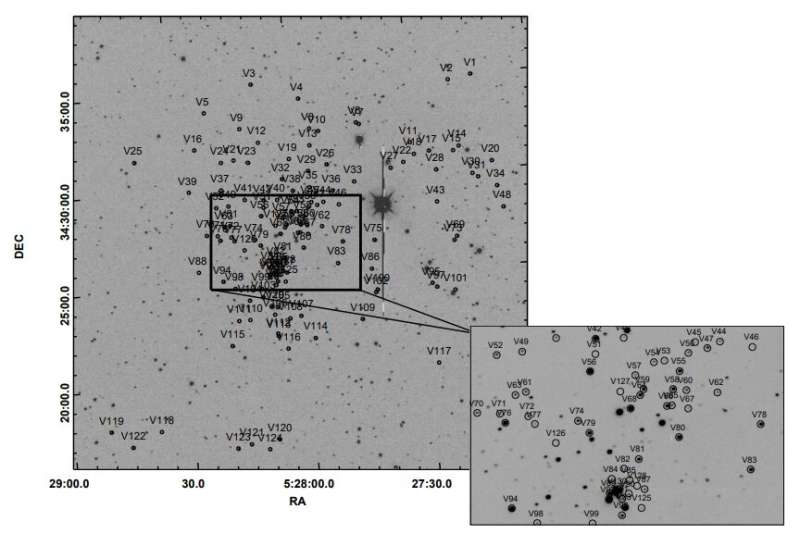June 24, 2019 report
Astronomers detect 130 short period variable stars

By conducting photometric observations of the open cluster Stock 8 and its surrounding region, astronomers have identified 130 short-period variable stars, classifying 51 of them as members of the cluster. A paper detailing the findings appeared June 18 on the arXiv pre-print repository.
Star clusters offer excellent opportunities to study stellar evolution as they are collections of stars with similar properties, for instance age, distance and initial composition. In particular, astronomers often search for variable stars in young clusters, which could be crucial in advancing the understanding of pre-main-sequence (PMS) stars, and therefore the initial phases of stellar evolution.
Estimated at about 3 million years old, Stock 8 is an extremely young open cluster located some 6,700 light years away, within the HII region IC 417 in the Auriga constellation. The cluster is known to contain a number of PMS, O/B-type as well as other main-sequence (MS) stars.
However, very little is known about the population of variable stars in Stock 8. So recently, a team of astronomers led by Sneh Lata of Aryabhatta Research Institute of Observational Sciences (ARIES) in India conducted time series photometry of the region containing this cluster to search for such stars. For this purpose, they employed ground-based telescopes located in India and Thailand. The observational campaign allowed the researchers to identify 130 variable stars and to classify most of them.
"We present time series photometry in the field of Stock 8 and identify 130 short period variable stars," the paper reads.
According to the study, 51 out of the 130 identified variables belong to Stock 8. Twenty-eight of them are main-sequence stars, while the rest were classified as pre-main-sequence stars. Fifty variables were identified as field stars, and 21 of them could belong to the blue plume (BP) population of the Norma-Cygnus arm. This leaves 29 stars of the sample still unclassified.
Furthermore, seven main-sequence variables were classified as slow pulsators of the B type, four remain uncharacterized, two were identified as Delta Scuti and one as Beta Cephei type. The remaining 14 MS variables could be new class variables, but given that their variability behavior is not easily explained, the astronomers propose additional photometric monitoring of these objects.
The research also found that the identified PMS variables are not older than 5 million years, and have masses ranging from 0.5 to 2.8 solar masses, noting also that they are most likely T Tauri stars.
"These pre-main-sequence stars could be T Tauri variables. We have found 5 and 2 of 23 PMS variables as classical T Tauri stars and Herbig Ae/Be stars, respectively, whereas 16 PMS stars are classified as weak-line T Tauri stars," the astronomers concluded.
More information: Sneh Lata et al. Short period variable stars in young open cluster Stock 8. arXiv:1906.07490v1 [astro-ph.SR]: arxiv.org/abs/1906.07490
© 2019 Science X Network




















